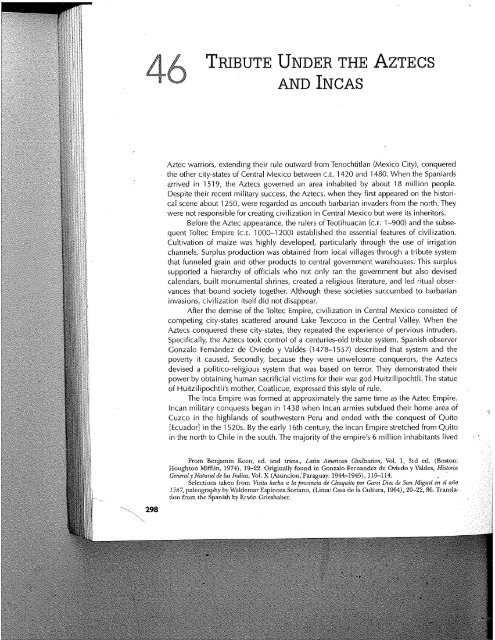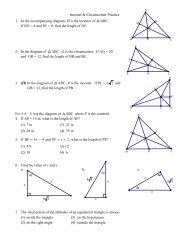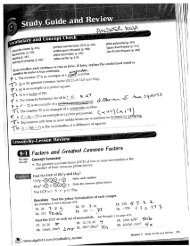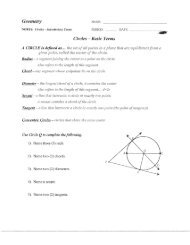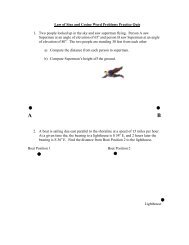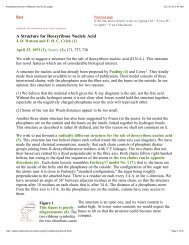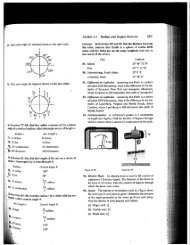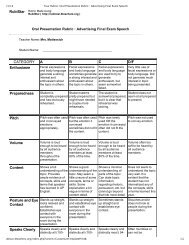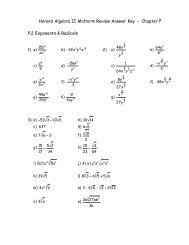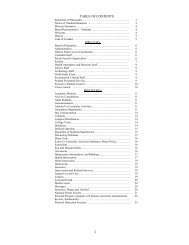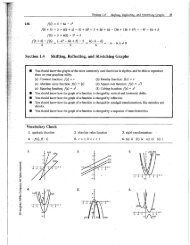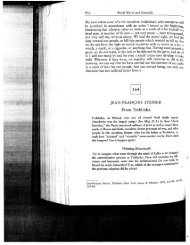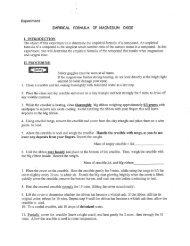tribute under the aztecs and incas - Pascack Valley Regional School ...
tribute under the aztecs and incas - Pascack Valley Regional School ...
tribute under the aztecs and incas - Pascack Valley Regional School ...
You also want an ePaper? Increase the reach of your titles
YUMPU automatically turns print PDFs into web optimized ePapers that Google loves.
TRIBUTE UNDER THE AZTECSAND INCASAztec warriors, extending <strong>the</strong>ir rule outward from Tenochtitlan (Mexico City), conquered<strong>the</strong> o<strong>the</strong>r city-states of Central Mexico between c.E. 1420 <strong>and</strong> 1480. When <strong>the</strong> Spaniardsarrived in 1519, <strong>the</strong> Aztecs governed an area inhabited by about 18 million people.Despite <strong>the</strong>ir recent military success, <strong>the</strong> Aztecs, when <strong>the</strong>y first appeared on <strong>the</strong> historicalscene about 1250, were regarded as uncouth barbarian invaders from <strong>the</strong> north. Theywere not responsible for creating civilization in Central Mexico but were its inheritors.Before <strong>the</strong> Aztec appearance, <strong>the</strong> rulers of Teotihuacan (c.a 1-900) <strong>and</strong> <strong>the</strong> subsequentToltec Empire (c.E. 1000-1200) established <strong>the</strong> essential features of civilization.Cultivation of maize was highly developed, particularly through <strong>the</strong> use of irrigationchannels. Surplus production was obtained from local villages through a <strong>tribute</strong> systemthat funneled grain <strong>and</strong> o<strong>the</strong>r products to central government warehouses. This surplussupported a hierarchy of officials who not only ran <strong>the</strong> government but also devisedcalendars, built monumental shrines, created a religious literature, <strong>and</strong> led ritual observancesthat bound society toge<strong>the</strong>r. Although <strong>the</strong>se societies succumbed to barbarianinvasions, civilization itself did not disappear.After <strong>the</strong> demise of <strong>the</strong> Toltec Empire, civilization in Central Mexico consisted ofcompeting city-states scattered around Lake Texcoco in <strong>the</strong> Central <strong>Valley</strong>. When <strong>the</strong>Aztecs conquered <strong>the</strong>se city-states, <strong>the</strong>y repeated <strong>the</strong> experience of pervious intruders~Specifically, <strong>the</strong> Aztecs took control of a centuries-old <strong>tribute</strong> system. Spanish observerGonzalo Fern<strong>and</strong>ez de Oviedo y Vald~s (1478-1557) described that system <strong>and</strong> <strong>the</strong>poverty it caused. Secondly, because <strong>the</strong>y were unwelcome conquerors, <strong>the</strong> Aztecsdevised a politico-religious system that was based on terror. They demonstrated <strong>the</strong>irpower by obtaining human sacrificial victims for <strong>the</strong>ir war god Huitzilipochtli. The statueof Hoitzilipochtli’s mo<strong>the</strong>r, Coatl~icue, expressed this style of rule.The Inca Empire was formed at approximately <strong>the</strong> same time as <strong>the</strong> Aztec Empire.Incan military conquests began in 1438 when Incan armies subdued <strong>the</strong>ir home area ofCuzco in <strong>the</strong> highl<strong>and</strong>s of southwestern Peru <strong>and</strong> ended with <strong>the</strong> conquest of Quito[Ecuador] in <strong>the</strong> 1520s. By <strong>the</strong> early 16th century, <strong>the</strong> Incan Empire stretched from Quitoin <strong>the</strong> north to Chile in <strong>the</strong> south. The majority of <strong>the</strong> empire’s 6 million inhabitants livedFrom Benjamin Keen, ed. <strong>and</strong> trans., Latin American Civilization, Vol. 1, 3rd ed. (Boston:Houghton Mifflin, 1974), 19-22. O~’iginally fbund in Gonzalo Fern<strong>and</strong>ez de Oviedo y Valdes, Histo*iaGeneraly Natural de Las India.s, Vol. X (Asuncion,’ Paraguay: 1944-1945), 110-114.Selections taken from Visita hecha a la p*vcinda de Chuquito ])or Garci Diez de San Miguel ~vl el ago1567, paleography by Waldemar Espinoza Soriano, (Lima: Ca.sa de la Cuhura, 1964), 20-22, 86. Translationfrom <strong>the</strong> Spanish by Erwin Grieshaber.
Chapter 4~ / Tribute Under <strong>the</strong> Aztecs <strong>and</strong> In as’,ASAZTECS(Mexico Citw. conqueredn <strong>the</strong> Spaniardsby about 18 million peoDe.histori~from <strong>the</strong> north. Theybut were its inheritors.1-900) <strong>and</strong> <strong>the</strong> subsefeaturesof civilizationthrough <strong>the</strong> use of irngationgh a <strong>tribute</strong> systemwarehouses. This surplusbut also aev~sed<strong>and</strong> led ritual obsersuccumbedto barbarianMexico consisted ofalley. When <strong>the</strong>’ ~ruders.system. Spamst~ observersystem an(~ <strong>the</strong>conquerors, <strong>the</strong> Aztecs’ demonstratecl <strong>the</strong>irJitzilipochtli. The s~atuele.Empire.area ofconquest of Quitore stretched from QuitoIlion inhabitants lived1, 3rd ed. (Boston:/ Valdes, Historla86, Transla-in <strong>the</strong> areas of present-day Peru <strong>and</strong> 13olivia. Three hundred years earlier, <strong>the</strong> Incas werea small village community competing with o<strong>the</strong>r villages in <strong>the</strong> highl<strong>and</strong>s of Cuzco.During <strong>the</strong> expansionary period, <strong>the</strong> Incas employed <strong>the</strong>ir traditional highl<strong>and</strong> socialpractices as <strong>the</strong> model for imperial organization. The ayllu, <strong>the</strong> smallest Andean socialunit, functioned on <strong>the</strong> basis of communal ownership of l<strong>and</strong>, communal work prac~rices, <strong>and</strong> strong traditions of mutual aid for those unable to work. But ayllus, for manygenerations before <strong>the</strong> Incas began <strong>the</strong>ir imperial expansion, were also part of largerunits, or chiefdoms. The organization of <strong>the</strong> chiefdom reflected a strong awareness of <strong>the</strong>economic potential of diverse ecological zones in <strong>the</strong> Andean area <strong>and</strong> revealed how<strong>the</strong> patterns of obligations to <strong>the</strong> chief enabled maximum exploitation of <strong>the</strong>se areas. In<strong>the</strong> highl<strong>and</strong>s (altiplano!, staple products consisted of potatoes, quinua [a type of grainthat only thrives in highl<strong>and</strong> areas <strong>and</strong> is also known as altiplano riceJ, <strong>and</strong> llama<strong>and</strong> alpaca products. In lower areas on <strong>the</strong> Pacific coast <strong>and</strong> in semitropical valleys off<strong>the</strong> eastern escarpment of <strong>the</strong> Andean range, staple products consist of maize, cotton,fruits, <strong>and</strong> coca (used for chewing <strong>and</strong> in rituals). The economic goal of a highl<strong>and</strong> chief~dom was to control as many ecological zones as possible from high to low. Anthropologistsdescribed this economic strategy as "verticality." This same goal lay behind <strong>the</strong>Incan system of governance. The noteworthy characteristics of <strong>the</strong> Inca Empire, includingforced migrations of people <strong>and</strong> road <strong>and</strong> bridge building, served not only to unite <strong>the</strong>empire but also to produce <strong>and</strong> dis<strong>tribute</strong> goods from all ecological zones. In contrastto <strong>the</strong> Aztec <strong>tribute</strong> system that in Operation emphasized strict control of conqueredpeople <strong>and</strong> swift punishment for nonpayment, <strong>the</strong> Incan <strong>tribute</strong> system emphasized<strong>the</strong> elevation of a traditional highl<strong>and</strong> practice (economic strategy of verticality) to <strong>the</strong>imperial level.The Kingdom of Chuquito was a pre-lnca chiefdom located in <strong>the</strong> highl<strong>and</strong>s on<strong>the</strong> western shore of Lake Titicaca that was incorporated into <strong>the</strong> Inca Empire. A Spanishgovernmental inquiry of 1567 clearly showed how <strong>the</strong> traditional patterns of obligationsowed to <strong>the</strong> chief con<strong>tribute</strong>d to exploitation of various ecological zones. In order toverify accounts, Spanish officials took testimony not only from <strong>the</strong> chief but also fromhis subjects. Although <strong>the</strong> chief’s (or cacique’s) authority dominated <strong>the</strong> relationshipbetween chief <strong>and</strong> worker, <strong>the</strong> chief never<strong>the</strong>less recognized his obligation to pay hisworkers, <strong>and</strong> workers openly expressed <strong>the</strong>ir anger if not properly paid.AZTEC TRIBUTE: OBSERVATIONS OFGONZALO FERNANDEZ DE OVIEDO Y VALD~.SThe Indians of New Spain, I have been told by reliable persons who gained <strong>the</strong>irinformation fl’om Spaniards who fought with Hern<strong>and</strong>o Cortes in <strong>the</strong> conquest ofthat l<strong>and</strong>, are <strong>the</strong> poorest of <strong>the</strong> many nations that live in <strong>the</strong> Indies at <strong>the</strong> presenttime. In <strong>the</strong>ir homes <strong>the</strong>y have no furnishings or clothing o<strong>the</strong>r than <strong>the</strong> poorgarments which <strong>the</strong>y wear on <strong>the</strong>ir persons, one or two stones for grinding maize,some pots in which to cook <strong>the</strong> maize, <strong>and</strong> a sleeping mat. Their meals consistchiefly of vegetables cooked with chili, <strong>and</strong> bread. They eat little--not that <strong>the</strong>ywould not eat more if <strong>the</strong>y could get it, for <strong>the</strong> soil is very fertile <strong>and</strong> yields bountifulharvests, but <strong>the</strong> common people <strong>and</strong> plebeians suffer <strong>under</strong> <strong>the</strong> tyranny of
300 Section Three / The Postclassical Period, 500-1500 ¢&: Expansions <strong>and</strong> Contacts<strong>the</strong>ir Indian lords, who tax away <strong>the</strong> greater part of <strong>the</strong>ir produce in a manner thatI sha!l describe. Only <strong>the</strong> lords <strong>and</strong> <strong>the</strong>ir relatives, <strong>and</strong> some principal men <strong>and</strong>merchants, have estates <strong>and</strong> l<strong>and</strong>s of <strong>the</strong>ir own; <strong>the</strong>y sell <strong>and</strong> gamble with <strong>the</strong>irl<strong>and</strong>s as <strong>the</strong>y please, <strong>and</strong> <strong>the</strong>y sow <strong>and</strong> harvest <strong>the</strong>m but pay no <strong>tribute</strong>. Nor is any<strong>tribute</strong> paid by artisans, such as masons, carpenters, fea<strong>the</strong>r-workers, or silversmiths,or by singers <strong>and</strong> kettle-drummers (for every Indian lord has musicians inhis household, each according m his station). But such persons render personalservice when it is required, <strong>and</strong> none of <strong>the</strong>m is paid for his labor.Each Indian lord assigns to <strong>the</strong> common folk who come from o<strong>the</strong>r parts of<strong>the</strong> country to settle on his l<strong>and</strong> (<strong>and</strong> to those who are already settled <strong>the</strong>re) specificfields, that each may know <strong>the</strong> l<strong>and</strong> that he is to sow. And <strong>the</strong> majority of <strong>the</strong>mhave <strong>the</strong>ir homes on <strong>the</strong>ir l<strong>and</strong>; <strong>and</strong> between twenty <strong>and</strong> thirty, or forty <strong>and</strong> fittyhouses have over <strong>the</strong>m an Indian head who is called tiq~itlato, which in tt~e Castiliantongue means "<strong>the</strong> finder (or seeker) of <strong>tribute</strong>." At harvest time this tiq~itlato,inspects <strong>the</strong> cornfield <strong>and</strong> observes what each one reaps, <strong>and</strong> when <strong>the</strong> reaping isdone <strong>the</strong>y show hint <strong>the</strong> harvest, <strong>and</strong> he counts <strong>the</strong> ears of corn that each hasreaped, <strong>and</strong> <strong>the</strong> number of wives <strong>and</strong> children that each of <strong>the</strong> vassals in his chargepossesses. And with <strong>the</strong> harvest before him he calculates how many ears of corneach person in that household wil! requite till <strong>the</strong> next harvest, <strong>and</strong> <strong>the</strong>se he givesto <strong>the</strong> Indian head of that house; <strong>and</strong> he does <strong>the</strong> same with <strong>the</strong> o<strong>the</strong>r produce,namely kidney beans, which are a kind of srnall beans, <strong>and</strong> chili, which is <strong>the</strong>ir pepper;<strong>and</strong> chia, which is as fine as mustard seed, <strong>and</strong> which in warm wea<strong>the</strong>r <strong>the</strong>ydrink, ground <strong>and</strong> made into a solution in water <strong>and</strong> used for medicine, roasted<strong>and</strong> ground; <strong>and</strong> cocoa, which is a kind of almond that <strong>the</strong>y use as money, <strong>and</strong>which <strong>the</strong>y grind, make into a solution, <strong>and</strong> drink; <strong>and</strong> cotton, in those placeswhere it is raised, which is in <strong>the</strong> hot l<strong>and</strong>s <strong>and</strong> not <strong>the</strong> cold; <strong>and</strong> pulque, which is<strong>the</strong>ir wine; <strong>and</strong> all <strong>the</strong> various products obtained from <strong>the</strong> maguey plant, ti’omwhich <strong>the</strong>y obtain food <strong>and</strong> drink <strong>and</strong> footwear <strong>and</strong> clothing. This plant grows in<strong>the</strong> cold regions, <strong>and</strong> <strong>the</strong> leaves resemble those of <strong>the</strong> cinnamon tree, but aremuch larger. Of all <strong>the</strong>se <strong>and</strong> o<strong>the</strong>r products <strong>the</strong>y leave <strong>the</strong> vassal only enough tosustain hint for a year. And in addition <strong>the</strong> vassal must earn enough to pay <strong>the</strong> <strong>tribute</strong>of mantles, gold, silver; honey, wax, lime, wood, or whatever products it is customaryto pay as <strong>tribute</strong> in that country. They pay this <strong>tribute</strong> every forty, sixty,seventy, or ninety days, according to <strong>the</strong> terms of <strong>the</strong> agreement. This <strong>tribute</strong> also<strong>the</strong> tiqttitlato receives <strong>and</strong> carr’~es to his Indian lard.Ten days before <strong>the</strong> close 9f <strong>the</strong> sixty or hundred days, or whatever is <strong>the</strong>period appointed for <strong>the</strong> payment of <strong>tribute</strong>, <strong>the</strong>y take to <strong>the</strong> house of <strong>the</strong> Indian!ord <strong>the</strong> produce brought by <strong>the</strong> tiquitlatos; <strong>and</strong> if some poor Indian should proveunable to pay his share of <strong>tribute</strong>, whe<strong>the</strong>r for reasons of health or poverty, or lackof work, <strong>the</strong> tiquitlato tells <strong>the</strong> lord that such-<strong>and</strong>-such will not pay <strong>the</strong> proportion of<strong>the</strong> <strong>tribute</strong> that had been assigned to him; <strong>the</strong>n <strong>the</strong> lord tells <strong>the</strong> tiq~itlato totake <strong>the</strong> recalcitrant vassal to a tia~g~e’z or market, which <strong>the</strong>y hold every five daysin all <strong>the</strong> towns of <strong>the</strong> l<strong>and</strong>, <strong>and</strong> <strong>the</strong>re sell hint into slavery, applying <strong>the</strong> proceedsof <strong>the</strong> sale to <strong>the</strong> payment of his <strong>tribute</strong> ....All <strong>the</strong> towns have <strong>the</strong>ir own l<strong>and</strong>s, long ago assigned for <strong>the</strong> provision of t-heord~ilobos or ques or temples where <strong>the</strong>y kept <strong>the</strong>ir idols; <strong>and</strong> <strong>the</strong>se l<strong>and</strong>s were <strong>and</strong> are<strong>the</strong> best of all. And <strong>the</strong>y have this custom: At seeding time all would go ibrth at <strong>the</strong>
." in a manner that~nd some principal men <strong>and</strong>sell <strong>and</strong> gamble with <strong>the</strong>irbut pay no <strong>tribute</strong>. Nor is anyfea<strong>the</strong>r-workers, or silver-Indian lord has musicians insuch persons render persona!for his labor.come from o<strong>the</strong>r parts of. settled <strong>the</strong>re) spe-And <strong>the</strong> majority of <strong>the</strong>m<strong>and</strong> thirty, or forty <strong>and</strong> fiftytiquitlato, which in <strong>the</strong> Castil-At harvest time this tiquitlato,<strong>and</strong> when <strong>the</strong> reaping isears of corn that each hasof <strong>the</strong> vassals in his chargehow many ears of cornt harvest, <strong>and</strong> <strong>the</strong>se he giveswith <strong>the</strong> o<strong>the</strong>r produce,is <strong>the</strong>ir pepmwarm weatber <strong>the</strong>yfor medicine, roasted<strong>the</strong>y use as money, <strong>and</strong>~, in those placespulque, which is~lant, fromThis plant grows intree, but arevassal only enough toenough to pay <strong>the</strong> trib-CUSeveryforty, sixty,This <strong>tribute</strong> alsoor whatever is <strong>the</strong>of <strong>the</strong> IndianIndian should prove,overty, or lackproportion of<strong>the</strong> tiquitlato mevery five days<strong>the</strong> proceeds¯ " of <strong>the</strong>l<strong>and</strong>s were <strong>and</strong> areforth at <strong>the</strong>smnmons of <strong>the</strong> town council to sow <strong>the</strong>se fields, <strong>and</strong> to weed <strong>the</strong>m at <strong>the</strong> propertime, <strong>and</strong> m cultivate <strong>the</strong> grain <strong>and</strong> harvest it <strong>and</strong> carry it to a house in which lived<strong>the</strong> pope <strong>and</strong> <strong>the</strong> teupisques, pioches, ex~uthles <strong>and</strong> piltoutles (o2; as we would say, <strong>the</strong>bishops, archbishops, <strong>and</strong> <strong>the</strong> canons <strong>and</strong> prebendaries, <strong>and</strong> even choristers, foreach major temple had <strong>the</strong>se five classes of officials). And <strong>the</strong>y supported <strong>the</strong>mselvesfrom this harvest, <strong>and</strong> <strong>the</strong> Indians also raised chickens for <strong>the</strong>m to eat.In all <strong>the</strong> towns Montezuma had his designated l<strong>and</strong>s, which <strong>the</strong>y sowed forhim in <strong>the</strong> same way as <strong>the</strong> temple l<strong>and</strong>s; <strong>and</strong> if no garrison was stationed in <strong>the</strong>irtowns, <strong>the</strong>y would carry <strong>the</strong> crops on <strong>the</strong>ir backs to <strong>the</strong> great city of Temistitan[Tenochtiti~in]; but in <strong>the</strong> garrison towns <strong>the</strong> grain was eaten by Montezuma’s sobdiers, <strong>and</strong> if <strong>the</strong> town did not sow <strong>the</strong> l<strong>and</strong>, it had to supply <strong>the</strong> garrison witt~ food,<strong>and</strong> also give <strong>the</strong>m chickens <strong>and</strong> all o<strong>the</strong>r needful provisions.INCA TRIBUTE: TESTIMONY OF MARTIN CARI,CHIEF (CACIQUE PRINCIPAL) OF THE LOWERDIVISION (ANANSAYA) OF CHUQUITOAsked what <strong>tribute</strong> is given to him each year by his subjects, he replied that from<strong>the</strong> town of Chuquito his subjects cultivate in some years 100 topos [a topo is ofindeterminate size but <strong>under</strong>stood to be <strong>the</strong> minimum l<strong>and</strong> needed for an Incacouple] of l<strong>and</strong> <strong>and</strong> in o<strong>the</strong>r years 70 topos of potatoes, quinua, <strong>and</strong> canagua[similar to quinua] ... in o<strong>the</strong>r towns [located on <strong>the</strong> western shore of Lake Titicaca<strong>and</strong> subject to Chuquito] of Acora, Ilave <strong>and</strong> Yunguyo his subjects cultivate~0 topos each <strong>and</strong> in <strong>the</strong> towns of Juli, Pomata <strong>and</strong> Zepita ano<strong>the</strong>r 20 toposeach.., in each topo of l<strong>and</strong> one can plant 3 fanegas [fa~ega as a g~in measureis about 1.5 bushels] of seed.., to plant one topo of l<strong>and</strong> 16 Indian males <strong>and</strong>8 Indian females are employed in plowing in one day.., to seed 5 Indian males<strong>and</strong> 8 Indian females are employed in one day.., to clean <strong>and</strong> weed <strong>the</strong> cuhivatedplots... 10 Indian females are employed tbr each topo of l<strong>and</strong> in oneday.., to <strong>the</strong>se Indian males <strong>and</strong> females who work <strong>the</strong> l<strong>and</strong> it is customary togive meat, potatoes, chu~o [freeze-dried potatoes], maize, quinua, coca, <strong>and</strong>chicha [maize beer] ... from <strong>the</strong> town of Chuquito <strong>and</strong> <strong>the</strong> o<strong>the</strong>r towns subjectto it each year 5 pieces of cloth are" woven from wool supplied to eachtown.., in addition <strong>the</strong> town of Cbuquito p~:ovides 40 to 50 Indians each year togo with [pack] animals provided by <strong>the</strong> cadq~e to bring maize from Mo~luegua<strong>and</strong> Sama [Peruvian coastal locations] <strong>and</strong> Capinota <strong>and</strong> Larecaja [Bolivian vableys] <strong>and</strong> coca from Cuzco to his home [in Chuquito] ... when d~e 40 Indiansfinish <strong>the</strong> trip <strong>the</strong>y work no more on that road <strong>and</strong> o<strong>the</strong>rs go... <strong>the</strong> round-triptakes two to three months <strong>and</strong> <strong>the</strong> Indians who are sent to <strong>the</strong>se locations aregiven fbr <strong>the</strong>ir maintenance chufio, dried meat, quinua <strong>and</strong> coca <strong>and</strong> <strong>the</strong>y arealso given wool to exchange for fbod from those parts.., fl’om <strong>the</strong> town ofChuquito <strong>and</strong> its subject towns 60 Indians of service are provided each year <strong>and</strong>10 are employed in guarding animals <strong>and</strong> 25 are employed in Moquegua workingon maize l<strong>and</strong>s <strong>and</strong> 15 are employed in guarding l<strong>and</strong>s in Chuquito <strong>and</strong> 10are employed in service in his home making cloth <strong>and</strong> taking care of household301
Section Tl~re~ / The Postclassical Period, 500-1500 ¢.E.: Expansions <strong>and</strong> Con~ctsduties <strong>and</strong> beyond <strong>the</strong> 60 already mentioned are 2 more employed in ga<strong>the</strong>ringtbdder <strong>and</strong> firewood.., as we!l as ano<strong>the</strong>r 20 who guard sheep.., from <strong>the</strong> tow~of Juli 10 Indians of service were given to ancestors of <strong>the</strong> current cacique whoguarded animals on <strong>the</strong> high plain <strong>and</strong> this group has now multiplied to 50 or 60Indians including men, women <strong>and</strong> children <strong>and</strong> <strong>the</strong>y now not only guard animalsbut also some have been sent to <strong>the</strong> Yungas [steep valley off <strong>the</strong> easternAndes] for maize <strong>and</strong> o<strong>the</strong>r necessities.., ano<strong>the</strong>r 2 Indians [i’om Juli which weregiven to <strong>the</strong> ancestors have now multiplied to 9 who also guard animals.., <strong>the</strong>town of Pomata does not provide one Indian because <strong>the</strong>y do not wish to <strong>and</strong> <strong>the</strong>town of Yunguyo provides I Indian to guard l<strong>and</strong> <strong>and</strong> <strong>the</strong> town of Zepita provides1 to guard l<strong>and</strong> <strong>and</strong> <strong>the</strong> towns of Acora <strong>and</strong> Ilave 3 each <strong>and</strong> all <strong>the</strong>se indianswho serve are given coca, tbod <strong>and</strong> sheep that <strong>the</strong>y raise for <strong>the</strong>mselves.Asked how many animals <strong>the</strong>se servants guard, he replied 300.Testimony of <strong>the</strong> Indians of Chuquito about Service to Their Cacique PrincipalAsked what service <strong>and</strong> <strong>tribute</strong> <strong>the</strong>y give to <strong>the</strong> cacique principal of Chuquito, hissubjects answered that <strong>the</strong>y provide 30 Indians for guarding l<strong>and</strong> <strong>and</strong> ano<strong>the</strong>r 20for guarding animals <strong>and</strong> in some years 2 pieces of c’urabi cloth [finest cloth madefrom vicufia wool] <strong>and</strong> in o<strong>the</strong>r years 3 pieces <strong>and</strong> sometimes even more.., in addition10 pieces of a’uasca [lesser quality cloth for commoners] are provided.., insome years 4 pieces <strong>and</strong> in o<strong>the</strong>r years nothing. ¯. [since] auasca cloth is given voluntarily..,<strong>and</strong> ti’om <strong>the</strong> sheep of <strong>the</strong> community we give <strong>the</strong> cacique around 30every year or a little more or less because in some years <strong>the</strong> cacique has guests <strong>and</strong>we give him more meat.., we cultivate 150,fi~negas [t~mega as l<strong>and</strong> measure is about1.6 acres] of potatoes <strong>and</strong> in o<strong>the</strong>r years we cultivate <strong>the</strong> same amount in quinua<strong>and</strong> <strong>the</strong> harvesting <strong>and</strong> preparing are done by all <strong>the</strong> members of <strong>the</strong> community,except <strong>the</strong> Indians who have been given in service.Asked what don Martin Cari gives to his subjects who serve <strong>and</strong> guard animals<strong>and</strong> l<strong>and</strong>, <strong>the</strong>y replied that those who guard anirnals are given coca, meat <strong>and</strong> o<strong>the</strong>rtbod plus wool so that <strong>the</strong>y can make clo<strong>the</strong>s for <strong>the</strong>mselves <strong>and</strong> to tbose who servein his house he gives food <strong>and</strong> wool to make clo<strong>the</strong>s <strong>and</strong> to those who serve himvery well he gives a live animal <strong>and</strong> to those who go <strong>and</strong> cultivate his l<strong>and</strong>s he givesmeat, chicha, potatoes, quinua <strong>and</strong> o<strong>the</strong>r food <strong>and</strong> to those who are cultivating hisl<strong>and</strong> he gives a good quantity because if he does not give it to <strong>the</strong>m <strong>the</strong>y willbecome angry. "STUDY QUESTIONS1. How did <strong>the</strong> Aztec <strong>tribute</strong> system work? What does such a <strong>tribute</strong> system indicateabout social organization in ancient Mexico?2. What types of work <strong>and</strong> goods constituted <strong>tribute</strong> in Chuquito that becamepart of <strong>the</strong> Incan system? What practices in Chuquito indicated that <strong>the</strong> relationshipbetween <strong>the</strong> subjects <strong>and</strong> <strong>the</strong> chief were reciprocal?3. Compare <strong>the</strong> Aztec method of acquiring <strong>tribute</strong> to <strong>the</strong> methods used by .<strong>the</strong> ....chieIs of Chuquito. What are <strong>the</strong> differences? What might account for <strong>the</strong>differences?


